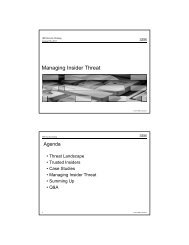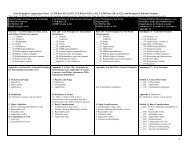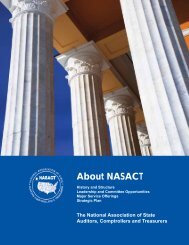Advisory Committee on Tax Exempt and Government Entities (ACT ...
Advisory Committee on Tax Exempt and Government Entities (ACT ...
Advisory Committee on Tax Exempt and Government Entities (ACT ...
You also want an ePaper? Increase the reach of your titles
YUMPU automatically turns print PDFs into web optimized ePapers that Google loves.
PROTECTING PLAN BENEFITS:IMPROVING GOVERNMENTAL DEFINED CONTRIBUTION PLAN COMPLIANCEAppendix EInternal Revenue Service’s Pre-Approved Qualified Plan ProgramOver the past 20 years, the use of Master <strong>and</strong> Prototype plans (“M&P plans”) <strong>and</strong>Volume Submitter plans (“VS plans” <strong>and</strong> together with M&P plans referred to hereinafteras “Pre-approved Plans”) has increased dramatically. The Internal Revenue Serviceestimates that at least 94% of all qualified retirement plans are Pre-approved Plans.In order for employer-sp<strong>on</strong>sored retirement plans, such as 401(k) plans, profit-sharingplans <strong>and</strong> defined benefit pensi<strong>on</strong> plans (including cash balance plans), to enjoy the taxbenefits offered to those employers <strong>and</strong> to employees covered by those plans, theInternal Revenue Code imposes a complex set of rules, which are implemented througha series of regulati<strong>on</strong>s, rulings <strong>and</strong> other IRS guidance. These Code requirementsinclude rules regarding (i) eligibility to participate, (ii) vesting of benefits, (iii) accrual ofbenefits or allocati<strong>on</strong> of employer <strong>and</strong> employee c<strong>on</strong>tributi<strong>on</strong>s, (iv) prohibiti<strong>on</strong>s <strong>on</strong>discriminati<strong>on</strong> in favor of highly-compensated employees, (v) distributi<strong>on</strong> of benefits,(vi) use of plan assets for the exclusive benefit of plan participants, <strong>and</strong> (vii) obligati<strong>on</strong>s<strong>and</strong> timing of required amendments to the plans.This series of lengthy <strong>and</strong> complex requirements imposed <strong>on</strong> qualified retirement plans,including the large number of permitted alternatives, requires knowledgeable assistancein the design, implementati<strong>on</strong> <strong>and</strong> <strong>on</strong>going administrati<strong>on</strong> of those plans.The <strong>ACT</strong> <strong>and</strong> the IRS has received anecdotal evidence as well as comments receivedin the surveys described later in this report that there has been much c<strong>on</strong>fusi<strong>on</strong> in thearea of qualified plans adopted by governmental entities. Part of the c<strong>on</strong>fusi<strong>on</strong>stemming from the fact that the current pre-approved program does not provideinformati<strong>on</strong> <strong>on</strong> the Code provisi<strong>on</strong>s that do or do not apply to governmental entities.Generally, there are two classificati<strong>on</strong>s into which all qualified retirement plans can bedivided, pre-approved plans <strong>and</strong> individually designed plans (“IDPs”). Pre-approvedplans are plans which are submitted to the IRS by a sp<strong>on</strong>soring organizati<strong>on</strong> <strong>and</strong>receive an opini<strong>on</strong> letter or advisory letter pre-approving the plan's language. An IDP isa plan which is specifically designed for <strong>on</strong>e employer or a group of employers <strong>and</strong> thensubmitted to the IRS for a determinati<strong>on</strong> letter. The purpose of the document approvalprocess is to provide employers <strong>and</strong> plans assurance that their plan document complieswith the requirements of the Code <strong>and</strong> other IRS guidance.Generally the approval process for a pre-approved plan is based <strong>on</strong> a 6-year approvalcycle. 30 Sp<strong>on</strong>soring organizati<strong>on</strong>s were required to submit defined c<strong>on</strong>tributi<strong>on</strong> Preapprovedplans to the IRS for EGTRRA <strong>and</strong> other requirements (outlined in the 2004Cumulative List) 31 by January 31, 2006. Those plans have received the new EGTRRAapproval letters <strong>on</strong> March 31, 2008, <strong>and</strong> may now be used by Employers to restate their3031Rev. Proc. 2005-66, 2005-37 I.R.B. 509Notice 2004-84, 2004-52 I.R.B. 1030ADVISORY COMMITTEE ON TAX EXEMPT AND GOVERNMENT ENTITIES (<strong>ACT</strong>) June 11, 2008 41













